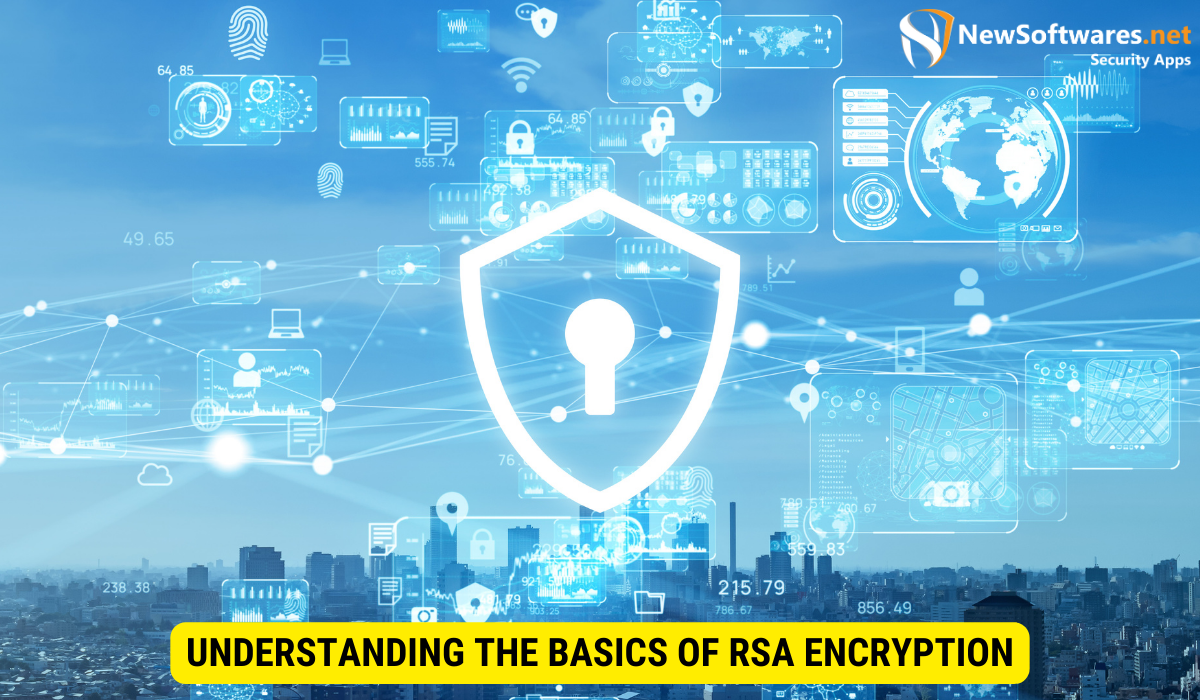Information security is of greatest importance in the digital age, where data is constantly transmitted and shared across various networks. One notable approach to safeguarding data is RSA encryption. This encryption method employs complex mathematical algorithms to ensure secure communication and protect against middleman attacks.
Together, we will explore the basics of RSA encryption, the threat of middleman attacks, the effectiveness of RSA encryption as a defense mechanism, and the implementation of RSA encryption in everyday technology.
Understanding the Basics of RSA Encryption

RSA encryption, named after its creators Ron Rivest, Adi Shamir, and Leonard Adleman, is one of the most widely-used encryption techniques in the world. Its popularity stems from its ability to provide secure communication over public networks. To grasp the significance of RSA encryption, we need to understand its genesis, key components, and the mathematical foundation on which it is built.
The Genesis of RSA Encryption
The development of RSA encryption can be traced back to the 1970s. Rivest, Shamir, and Adleman sought to create a method for securely transmitting information in the era of public-key cryptography. Their breakthrough came with the realization that different keys could be used for encryption and decryption, revolutionizing the field of cryptography.
During this time, the need for secure communication was becoming increasingly important. Traditional encryption methods relied on a single key for both encryption and decryption, which meant that the key had to be shared between the sender and the receiver. This posed a significant security risk, as intercepting the key would allow unauthorized access to the encrypted data.
Rivest, Shamir, and Adleman’s innovation was to introduce the concept of public and private keys. With RSA encryption, the public key is freely shared and used for encrypting sensitive information, while the private key remains secret and is used for decrypting the encrypted data. This breakthrough allowed for secure communication without the need to share a single key.
Key Components of RSA Encryption
RSA encryption relies on three key components: public key, private key, and the mathematical operations associated with these keys. The public key is freely shared and used for encrypting sensitive information, while the private key remains secret and is used for decrypting the encrypted data. The relationship between these keys is mathematically intricate and forms the core of the RSA encryption method.
The public key is generated by selecting two large prime numbers and performing various mathematical calculations. These calculations involve modular arithmetic, which is a branch of number theory that deals with remainders. The private key is derived from the public key using additional mathematical operations that are computationally difficult to reverse.
One of the key advantages of RSA encryption is that the civic key can be freely shared without compromising the safety of the encrypted data. This allows anybody to send encrypted messages to the owner of the private key, ensuring secure communication over public networks.
The Mathematical Foundation of RSA
At the heart of RSA encryption lies number theory and modular arithmetic. The process involves selecting two large prime numbers, performing various mathematical calculations, and generating the public and private keys. Building upon the difficulty of factoring large prime numbers, RSA encryption ensures that the data remains secure even when transmitted across insecure networks.
The security of RSA encryption relies on the fact that it is computationally difficult to factorize large prime numbers. The larger the prime numbers used in the encryption process, the more secure the encrypted data becomes. This is because factoring large prime numbers into their constituent primes is a time-consuming task that requires significant computational resources.
By leveraging the difficulty of factoring large prime numbers, RSA encryption provides a robust method for secure communication. The mathematical foundation of RSA ensures that even if an attacker intercepts the encrypted data, they would need to factorize the large prime numbers to obtain the original message. This task is currently infeasible given the computational limitations of modern computers.
In conclusion, RSA encryption is a groundbreaking encryption technique that revolutionized the field of cryptography. Its ability to provide secure communication over public networks has made it one of the most widely-used encryption methods in the world. By understanding the genesis, key components, and mathematical foundation of RSA encryption, we can appreciate the importance and complexity of this powerful encryption method.
The Threat of Middleman Attacks
Middleman attacks pose a significant threat to data security. These attacks occur when an invader intercepts and alters communication among two parties who believe they are directly communicating with each other. Understanding the nature of middleman attacks, how they work, and their consequences is crucial in appreciating the importance of robust encryption mechanisms.
Defining Middleman Attacks
A middleman attack, also known as a man-in-the-middle attack, involves an attacker who intercepts communication between two parties and secretly alters the content exchanged. The objective of these attacks can vary ranging from gathering sensitive information to manipulating data for malicious purposes.
How Middleman Attacks Work
During a middleman attack, the attacker positions themselves between the communicating parties, intercepting their messages. The attacker can then modify the messages or insert their own content before forwarding them to the intended recipient. This interception occurs undetected, leaving both parties unaware of the presence of the attacker.
The Impact of Middleman Attacks on Data Security
Middleman attacks compromise data security on multiple levels. They can lead to the publicity of sensitive information, such as passwords, financial details, and personal data. Moreover, they can undermine the integrity of exchanged data by altering its contents, potentially leading to severe consequences for individuals and organizations.
RSA Encryption as a Defense Mechanism
RSA encryption serves as a robust defense mechanism against middleman attacks and ensures secure communication between parties. By leveraging the asymmetric encryption algorithm and the strength of large prime numbers, RSA encryption provides a high level of data security.
The Role of RSA in Data Protection
The primary function of RSA encryption is to protect data during transmission. By utilizing asymmetric encryption, it enables the secure exchange of sensitive information over public networks. The encrypted data can only be deciphered using the unique private key possessed by the intended recipient, thereby preventing unauthorized access.
RSA Encryption and Secure Communication
RSA encryption plays a crucial role in establishing secure communication channels. It guarantees confidentiality by encrypting data, and it also verifies the authenticity of the sender through the use of digital signatures. These features foster trust between individuals and organizations, enabling them to exchange information securely without the fear of middleman attacks.
Strengths and Limitations of RSA Encryption
Like any encryption method, RSA has its strengths and limitations. Its strengths lie in its ability to provide secure communication, its resistance to brute-force attacks due to the use of large prime numbers, and its prevalence in various technologies. However, RSA encryption can be computationally expensive, slowing down the encryption and decryption processes.
Implementing RSA Encryption

The widespread adoption of RSA encryption in everyday technology reflects its importance in data protection. Understanding how RSA encryption is implemented, setting it up, and ensuring its continuous maintenance are crucial steps in safeguarding data from middleman attacks.
RSA Encryption in Everyday Technology
RSA encryption is extensively used in various technologies, including secure websites (HTTPS), virtual private networks (VPNs), secure email protocols (S/MIME, PGP), and digital signatures. Its presence in these technologies ensures secure communication, protects sensitive data, and enhances overall information security.
The Process of Setting Up RSA Encryption
Implementing RSA encryption involves multiple steps. First, the generation of the public and private keys takes place. Then, these keys are distributed to the intended parties within a secure channel. Finally, the encryption and decryption processes are integrated into the communication systems, allowing for the secure exchange of data.
Maintaining and Updating RSA Encryption Systems
To ensure the longevity and efficiency of RSA encryption systems, regular maintenance and updates are essential. This includes updating the encryption algorithms, monitoring for emerging vulnerabilities, and promptly replacing compromised keys.
Key Takeaways
- RSA encryption is a widely-used encryption method that ensures secure communication over public networks.
- Middleman attacks pose a significant threat to data security by intercepting communication and altering its contents.
- RSA encryption serves as a defense mechanism against middleman attacks, protecting data during transmission.
- Implementing RSA encryption involves generating public and private keys, distributing them securely, and integrating encryption processes into communication systems.
- Regular maintenance and updates are crucial for maintaining the effectiveness of RSA encryption systems.
FAQs
What is RSA encryption?
RSA encryption is a cryptographic method that uses complex mathematical algorithms, public and private keys, and large prime numbers to ensure secure communication and data protection.
How does RSA encryption defend against middleman attacks?
RSA encryption defends against middleman attacks by encrypting data using the recipient’s public key, which can only be decrypted using the corresponding private key possessed by the intended recipient.
What are the strengths of RSA encryption?
Strengths of RSA encryption include its ability to provide secure communication, resistance to brute-force attacks, prevalence in various technologies, and its role in establishing trust through digital signatures.
What are the limitations of RSA encryption?
The main limitation of RSA encryption is its computational cost, which can slow down the encryption and decryption processes.
How is RSA encryption implemented in everyday technology?
RSA encryption is implemented in technologies such as secure websites, virtual private networks, secure email protocols, and digital signatures, ensuring secure communication and data protection.
Conclusion
RSA encryption plays a vital role in safeguarding data from middleman attacks, enabling secure communication over public networks. Its ability to encrypt and decrypt data using distinct public and private keys provides a strong defense against unauthorized access. By understanding the basics of RSA encryption, the threat of middleman attacks, the effectiveness of RSA as a defense mechanism, and the implementation process, individuals and organizations can enhance their data security and protect sensitive information.
